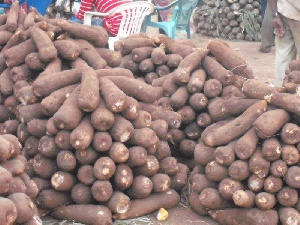Out of a possible 100,000 tonnes of yam available to exporters per annum only about 25,000 to 30,000 tonnes get exported, as factors like excessive use of chemicals by farmers, poor handling, and delays at the ports make the produce perish faster.
The country thus earns less than a billion dollars from exporting the root tuber, which is supposed to be the third-largest foreign exchange earner among the non-traditional export commodities.
The target, meanwhile, is to do US$5billion dollars of exports by the fifth year of a National Yam Development Strategy that was outdoored in October 2013.
“So in terms of the numbers that get exported, we are dealing with around 30% to 40% of what we actually target to export,” Nana Kodwo Adentwi, Coordinator of the Yam Development Council that oversees the strategy, told the B&FT.
“When it gets over [to the country of export], we still lose some of those. And so if you spoke to the exporters out there, they would tell you that almost all the time when they have shipped and have to wait to be paid they end up losing not less than 20% of what they had expected to be paid for their produce,” he said.
The yam development strategy has five key milestones, including a plan to increase the export of fresh yam.
Practical challenges of the sector and scarcity of funds are, however, making the job tougher for the council by the minute.
“We don’t have any properly-done pack houses on the farms or in the market places where the yam is normally aggregated. It is a delicate commodity, so you need to transport it properly,” Nana Adentwi said.
“These practical challenges can be overcome when we have the right infrastructure and if we are doing the right things in terms of monitoring the quality of the yield through the way we actually cultivate it. The numbers as of today are not looking very good,” he added.
The council is considering introducing to food processors innovations like yam-wine, yam-powder and slicing up the fresh yam and vacuum packing it for export, and even domestic consumption.
If the plans materialise, slices of packaged yam could be purchased in supermarkets and sent home to be cooked.
“As we have structured in the strategy document, between now and five years to come we should be able to see some key changes in the way we handle the yam and the businesses around it,” Nana Adentwi said.
“The [yam development] strategy envisions making Ghana the leading source of premium quality yam products with global penetration and contributing to an improved Ghanaian economy and livelihoods,” Ahmed Yakubu Alhassan, Deputy Minister for Food and Agriculture, said at the launch of the strategy.
“One of the objectives of the strategy is to develop commercially-driven research and development as well as capacity building in the yam value chain,” he added.
Business News of Tuesday, 3 November 2015
Source: B&FT













